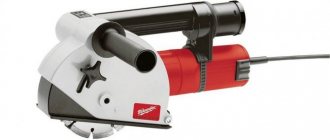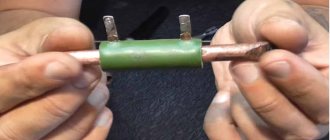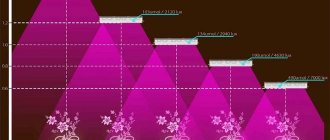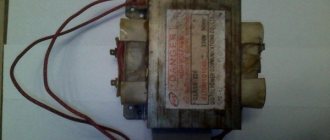Aerated concrete blocks, due to their high technical characteristics, are widely used both in individual construction and in the construction of commercial and industrial buildings. These products are made with minimal variation in geometric parameters: therefore, the masonry seam is very thin. Reinforcement, which must be done every 3-4 rows of masonry using reinforcing mesh, unjustifiably increases the thickness of the masonry joint, which negatively affects the heat-saving properties of the structure. Therefore, reinforcing bars are placed in grooves, for the manufacture of which you will need a wall chaser for aerated concrete.
You cannot do without such a device when arranging internal hidden electrical wiring, as well as when making grooves for pipelines and laying other communication networks (Internet, television cable, wired telephone, etc.).
Types of wall chasers for aerated concrete
Aerated concrete belongs to cellular concrete, its density is 4–5 times less than that of ordinary concrete. Therefore, for its processing and gating, you can use not very powerful tools (and even manual ones with success).
All devices for making grooves are divided into electric and manual. Now on sale you can find a huge variety of different electric wall chasers (single, double, multi-disc, milling) at prices ranging from 4,000 to 40,000 rubles from different manufacturers. Almost any model is suitable for cutting grooves in aerated concrete.
However, given that aerated concrete blocks are quite easy to process, many builders have come to the conclusion that a manual wall chaser for aerated concrete is quite suitable for making grooves. Manufacturers of hand tools: Petrotech, Aeroc, H+H, Remocolor, KSMI. The price for these products is quite affordable and ranges from 450 to 850 rubles. There are two types of furrow machines for working with aerated concrete:
- Hand-held devices designed for making grooves on horizontal surfaces. They have a shorter and curved handle and are designed for cutting grooves for laying reinforcing rods.
- Products designed for cutting grooves on vertical wall surfaces. These devices have a longer and straighter handle.
On a note! The division of manual wall chasers is very arbitrary; everyone chooses their own convenient tool to use.
Both types of manual wall chasers have common advantages:
- low price;
- light weight;
- simplicity of design and reliability in operation;
- minimal dust formation and noise during work;
- durability;
- energy independence (that is, they are not afraid of power outages: and this is very important in suburban construction).
Manual model for working with aerated concrete
It is better to cut grooves in aerated concrete blocks at the stage of laying the wall. The worker does not need to lean to the side, holding the weight of the tool with his hands, which can affect the quality of the grooves.
Work with a manual wall chaser is carried out in the following order:
- Aerated concrete blocks are placed sequentially on a level base.
- The end of the last block is supported with a wedge or fixed in another way.
- Using a tape measure or ruler, mark the center line of the future groove with a marker.
- If it is difficult to make the first cut, then use a chisel to knock out the starting notch.
- By moving the tool with little effort, a channel is formed on all blocks;
- Aerated blocks are placed on the wall being built.
Factory-made furrower
Homemade wall chaser for aerated concrete
Having some plumbing skills, you can make a wall chaser for aerated concrete with your own hands without much difficulty and with little investment.
Manual wall chaser
The simplest device can be made from a piece of ordinary metal fastening perforated tape. Using a hacksaw for metal, we cut a strip 40÷45 cm long, bend it in half, form a scraper at the bend (we choose the configuration and dimensions depending on the desired width of the groove), connect the two free ends together and wrap them with several layers of electrical tape (that is, we get something like a handle), saw off the excess. We get a cheap, but quite practical wall chaser for aerated concrete blocks. Having pressed our device along the aerated concrete several times (usually no more than 4÷5), we get a neat furrow. If desired, you can make a handle, for example, from a wooden block.
A little more complicated, but a more reliable wall chaser for aerated concrete can be made with your own hands from a piece of water pipe. Manufacturing procedure:
- Using a grinder, we cut a piece 100÷120 mm long from the pipe (we select the diameter depending on the width of the required groove) at an angle of 45˚.
- We weld it to the reinforcement bar (diameter 12÷14 mm) at a right angle. If we use the rest of a water pipe as a handle, then we weld the cutting part to it at an angle of 30÷40˚.
- We bend the reinforcement in the area of the welding site at an angle convenient for gating.
Another option for making a manual wall chaser for aerated concrete with your own hands:
- We use a wood crown saw as the cutting element. Bend it using pliers into a triangle shape with rounded corners.
- A piece of water pipe is suitable for the handle. From one end, using a hacksaw, we make a cut with a depth equal to the width of the cutting blade.
- We insert the cutting workpiece into the cut, drill a hole in the pipe and the workpiece and screw a self-tapping screw into it.
On a note! Since it is quite simple to make a wall chaser for making grooves in aerated concrete, everyone can choose the design of the cutting element and the length of the handle independently.
Simple electric wall chaser for aerated concrete
The ease with which you can groove aerated concrete for wiring allows you to make a wall chaser from a regular electric drill. To do this, you will need a cylindrical cutter (average cost 450÷550 rubles), which we install in the drill chuck. This simple device allows you to make grooves in aerated concrete walls quickly and efficiently. Since a large amount of dust is generated during the work, it is better to do the gating together (the second person works with a vacuum cleaner), and also use goggles and a respirator. If desired, you can make a wooden sled into which we attach the drill. This device will allow you to make a groove of the same depth along its entire length. Although, after practicing on a block, which probably (at least one) was left after construction was completed, you can make neat grooves without complicating the design, using only a drill and a cutter.
Design and operating principle
DIY Mimo 4g lte antenna
The device for cutting cracks in walls can be an electromechanical unit or a simple manual wall chaser.
Electric
The professional tool is equipped with two saw blades, which are located parallel to each other. By rotating, they cut grooves of a given depth in aerated concrete blocks or similar materials. If the channel width is small, then the aerated concrete caught between the longitudinal slots can be easily removed with a chisel. In the case of a wide groove, the material is selected using a perforator.
Electric wall chaser
Important! An electromechanical wall chaser for aerated concrete is quite expensive. It is beneficial for professionals to use for large volumes of work.
Manual
It is not profitable to purchase an expensive electromechanical unit for wiring hidden communications within the walls of a private home. It’s enough to make a wall chaser with your own hands. The design of the device depends on the resourcefulness and experience of the home craftsman. It is made from auxiliary materials.
Self-production of an electric wall chaser
At home, you can assemble an electric furrower from an ordinary grinder yourself. But, as most masters assure, this makes no sense, and here’s why:
1. A wall chaser made from an angle grinder has low productivity and, in addition, all the disadvantages of a factory device, such as a high noise level and dust generation during the cutting process of the block.
2. To use a homemade tool, you need a powerful industrial vacuum cleaner, otherwise the work will be completely ineffective.
3. If it is not possible to mount two cutting discs on one axis of the angle grinder, cutting each groove will have to be carried out in several stages, and this will increase the working time and the amount of dust.
4. A wall chaser made from an angle grinder does not allow you to accurately adjust the width between the discs, so the result may be of poor quality.
5. Self-assembled devices can be dangerous, because when assembling them, people often do not read the manual or instructions for the wall chaser, and even less often, follow the safety rules.
Kawabanga! How to coat concrete outdoors to protect it from destruction: all methods and materials
Thus, if large-scale work is not planned, it is better to use a simple tool. But it must be remembered that it can only be used to process aerated concrete; a block with a denser structure will be beyond its capabilities.
Assembling the furrow machine takes place in two stages:
- The first cutting disc is installed in the usual way and carefully tightened with a fastening nut.
- The second disk is installed on top of the first and is also tightly tightened with a nut.
The casing can be made from different materials: an unnecessary plastic container or bottle, or from a metal sheet. The main thing is that when creating it, do not forget to make a tube for connecting an industrial vacuum cleaner.
The nozzle should be tightly connected to the vacuum cleaner hose and located in the upper part of the casing so that all dust from the working area is immediately sucked inside.
Not long ago, a furrow cutter appeared on sale in appearance and principle of operation, reminiscent of a hand saw, but with an oval-shaped working attachment at the end. Such a tool quickly and easily makes grooves in the surface, especially if the aerated concrete is completely fresh.
Self-production
DIY equipment must be reliable, versatile and low cost. High precision manufacturing is not required, but the craftsman must be able to process metal and assemble mechanisms.
Universal manual wall chaser
The tool is simple. Craftsmen only need to have a welding machine at home. Procedure:
The handles are wrapped with electrical tape or a rubber hose is put on them - this makes it more convenient to hold the tool. It is preferable to use a metal plate as the cutting edge because it can be sharpened.
Option with electric motor
The basis of an electric wall chaser is an electric motor, which determines the characteristics of the tool. A grinder is used as the basis for a homemade apparatus.
Assembly order:
A homemade electric wall chaser for gas blocks can be converted back into an angle grinder. The owner will save a significant amount on such a device, since he will actually receive two tools in one.
Kawabanga! Lithium impregnations – protection of concrete to the entire depth of the screed
Problems of high dust generation are solved by making a casing to which a tube from a vacuum cleaner is attached. This way, almost all the garbage will be removed from the work area and will not cause inconvenience.
The casing is made from a plastic bottle or container. The main condition for creation is that it must have the shape of a semicircle and fit tightly to the plane of the material being processed. The pipe is placed in the upper part of the casing so that dust is absorbed more efficiently.











